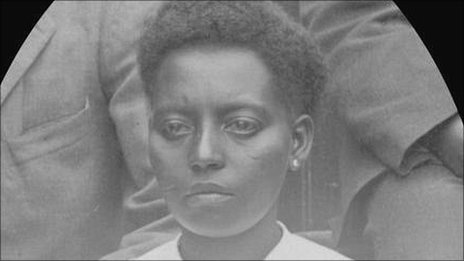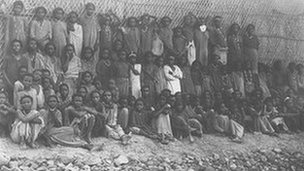From: Berhane Habtemariam (Berhane.Habtemariam@gmx.de)
Date: Thu Aug 25 2011 - 17:58:11 EDT
How an Ethiopian slave became a South African teacher
Sandra Rowoldt ShellUniversity of Cape Town
25 August 2011 Last updated at 00:32 GMT
Bisho was one of a group of Ethiopian slaves freed by a British warship in
1888 off the coast of Yemen, then taken round the African coast and placed
in the care of missionaries in South Africa.
"We were overawed in her presence and by the way she would mumble to herself
in this language none of us understood," recalls Mr Alexander, now 74.
This was Ethiopia's Oromo language, Bisho's mother tongue, which she
reverted to as she grew older.
Mr Alexander, who was a political prisoner in the 1960s, sharing Robben
Island with Nelson Mandela, is today one of South Africa's most eminent
educationists.
He remembers his younger siblings asking their mother, Dimbiti: "What's Ma
talking about... what's the matter with her? What's she saying?"
Their mother would respond: "Don't worry about Ma... she's just talking to
God."
When he was in his late teens, his mother told him about his Ethiopian
origins but Mr Alexander thinks even she may not have known all the details,
which he only discovered when he was in his fifties.
He found out that the freed Ethiopians had all been interviewed on their
arrival in South Africa.
The story began on 16 September 1888, when Commander Charles E Gissing,
aboard the British gunship HMS Osprey, intercepted three dhows carrying
Ethiopians to the slave markets in the Arabian port of Jeddah.
Sold for maize
Commander Gissing's mission was part of British attempts to end the slave
trade - a trade that London had supported until 1807, when it was abolished
across the British Empire.
The Oromo, despite being the most populous of all Ethiopian groups, had long
been dominated by the country's Amhara and Tigrayan elites and were
regularly used as slaves.
Emperor Menelik II, who has been described as Ethiopia's "greatest slave
entrepreneur", taxed the trade to pay for guns and ammunition as he battled
for control of the whole country, which he ruled from 1889 to 1913.
Bisho Jarsa was among the 183 children found on the dhows.
She had been orphaned with her two brothers, as a result of the drought and
disease that swept through Ethiopia in 1887, and left in the care of one of
her father's slaves.
But the continuing threat of starvation resulted in Bisho being sold to
slave merchants for a small quantity of maize.
After a journey of six weeks, she reached the Red Sea, where she was put on
board one of the Jeddah-bound dhows intercepted by HMS Osprey.
Her first memory of the British was the sound of automatic gunfire blasting
into the sails and rigging of the slave dhow while she huddled below deck
with the other Oromo children.
They all fully expected to be eaten as this is what the Arab slave traders
had told them would happen if they were captured by the British.
But Commander Gissing took the Oromo to Aden, where the British authorities
had to decide what to do with the former slaves.
The Muslim children were adopted by local families. The remaining children
were placed in the care of a mission of the Free Church of Scotland - but
the harsh climate took its toll and by the end of the year 11 had died.
The missionaries sought an alternative home for them, eventually settling on
another of the Church's missions, the Lovedale Institution in South Africa's
Eastern Cape - on the other side of the continent.
Bisho and the rest of the children reached Lovedale on 21 August 1890.
The missionaries recorded detailed histories of the former slaves, educated
them and baptised them into the Christian faith.
Mandela fascinated
Life was tough here too, however, and by 1903, at least another 18 of the
children had died.
In that year, the Lovedale authorities asked the survivors whether they
would like to return to Ethiopia.
Some opted to do so, but it was only after a protracted process, involving
the intervention of German advisers to Emperor Menelik, that 17 former
slaves sailed back to Ethiopia in 1909.
The rest had by this time married or found careers and opted to stay in
South Africa.
Bisho was trained for domestic service, but she must have shown signs of
special talent, because she was one of only two of the Oromo girls who went
on to train as a teacher.
In 1902 she left Lovedale and found a position at a school in Cradock, then
in 1911 she married Frederick Scheepers, a minister in the church.
Frederick and Bisho Jarsa had a daughter, Dimbiti. Dimbiti married David
Alexander, a carpenter, and one of their children, born on 22 October 1936,
was Neville Alexander.
By the 1950s and 60s he was a well-known political activist, who helped
found the short-lived National Liberation Front.
He was arrested and from 1964 until 1974 was jailed in the bleak prison on
Robben Island.
His fellow prisoners, Nelson Mandela and Walter Sisulu, were fascinated by
his part-Ethiopian origins but at the time, he was not aware that his
grandmother had been captured as a slave and so they could not draw any
comparisons with their own fight against oppression.
So what did he feel when he found out how is grandmother had ended up in
South Africa?
"It reinforced my sense of being an African in a fundamental way," he told
the BBC.
Under apartheid, his family was classified as Coloured, or mixed-race,
rather than African.
"We always struggled against this nomenclature," he said.
He also noted that it explained why he had often been mistaken for an
Ethiopian during his travels.
The strongest parallel he can draw between his life and that of his
grandmother is the role of schooling.
"Her real liberation was not the British warship but the education she later
received in South Africa," he said.
"Equally, while on Robben Island, we turned it into a university and ensured
that all the prisoners learned to read and write, to prepare them for their
future lives."
Bisho Jarsa, trained as a domestic servant, went on to become a teacherBisho
Jarsa, trained as a domestic servant, went on to become a teacher
When Neville Alexander used to visit his maternal grandmother Bisho Jarsa as
a boy, he never suspected the extraordinary story of how she had come from
Ethiopia to the South African city of Port Elizabeth.
Ethiopian children, enslaved in Ethiopia, freed by the British navy arrive
in Aden. Photo: University of Cape TownOn their arrival in Yemen, the
children were looked after by local families and missionaries
All the 204 slaves freed by Commander Gissing were from the Oromo ethnic
group and most were children.


------------[ Sent via the dehai-wn mailing list by dehai.org]--------------